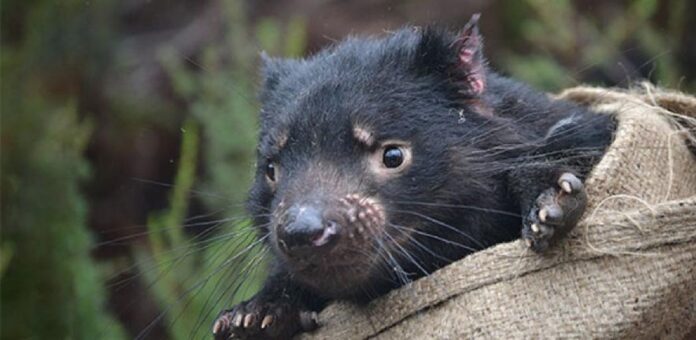Researchers have identified mutations that may drive the spread of deadly diseases and the family trees of two transmissible cancers that affect Tasmanian devils.
Transmissible cancers, uncommon in the animal kingdom, spread through the transfer of living cancer cells.
Tasmanian devils are vulnerable to two fatal transmissible cancers known as devil facial tumor 1 (DFT1) and devil facial tumor 2 (DFT2), which have resulted in dramatic population reduction in recent decades. Both cancers present with disfiguring face tumors.
In a new study, researchers from the University of Cambridge worked with a global team of experts from Europe, Australia, and the United States to track the genesis and mutations of DFT1 and DFT2, as well as define their continuous evolution.
The researchers discovered that DFT2 acquired mutations around three times faster than DFT1. The most likely reason is that DFT2 is a more rapidly growing cancer than DFT1, which first appeared between 2009 and 2012.
In Tasmanian devils, the cells are transferred by biting, a behavior common in devils, especially during battles over mates and food.
Lead author Elizabeth Murchison, Professor of Comparative Oncology and Genetics at the Department of Veterinary Medicine, University of Cambridge, said, “The incredible fact that Tasmanian devils have not one, but two, transmissible cancers, makes it possible to compare their evolution, and this gives us new insights into the key mechanisms involved.”
He added, “By looking at the mutations that have accumulated in these cancers’ DNA, we can trace the origins and evolution of these diseases. Our results show that the two cancers arose through similar processes and have striking signals of ongoing evolution. It is difficult to predict how this continued cancer evolution will impact devils.”
The researchers produced an improved reference genome’ of the Tasmanian devil, essentially a map of the whole DNA sequence, and compared it to DNA from 119 DFT1 and DFT2 tumors.
DFT1 was discovered in 1996 in Tasmania’s northeast and has since spread throughout the state. DFT2, on the other hand, was found in 2014 and is currently restricted to a tiny area in Tasmania’s southeast.
The team found that DFT1 arose in the 1980s, up to 14 years before it was first observed, whereas DFT2 emerged between 2009 and 2012, only shortly before it was detected.
The researchers found tumor mutations and utilized them to create ‘family trees’ of how the two cancers grew separately over time.
Maximilian Stammnitz, the study’s first author, said, “DFT2 is still not widespread in the devil population, and very little is known about it. They were startled to see how quickly it was mutating, alerting us to what could be a very unpredictable threat to the devils in the long term.”
Mapping the mutations revealed that DFT1 experienced an explosive transmission event shortly after its discovery. A single infected devil transmitted its tumor to at least six recipient devils.
DFT1 has now spread throughout practically the entire devil population. It has recently been recorded in Tasmania’s far northwest, one of the state’s few remaining disease-free regions.
Researchers also discovered DFT1 transmission between a mother and her young in her pouch for the first time.
They discovered that the incubation period between infection and the appearance of symptoms could be a year or more in some cases. These discoveries have important consequences for conservationists seeking to save the species.
Murchison said, “I come from Tasmania and love Tasmanian devils they have a special place in my heart. Transmissible cancers pose an unprecedented and unpredictable threat to Tasmanian devils. This research highlights the continuing importance of monitoring and conservation programs. It also gives us new insights into the evolutionary mechanisms operating in cancer more broadly, including in human cancers.”
The results highlight the ongoing threat that transmissible cancers represent to Tasmanian devils.
The Gates Cambridge Trust, the Eric Guiler Tasmanian Devil Research Grants from the University of Tasmania Foundation, and Wellcome all provided funding for the study.
Journal Reference:
- Stammnitz, M. R., Gori, etal. The evolution of two transmissible cancers in Tasmanian devils. Science. DOI: 10.1126/science.abq6453
